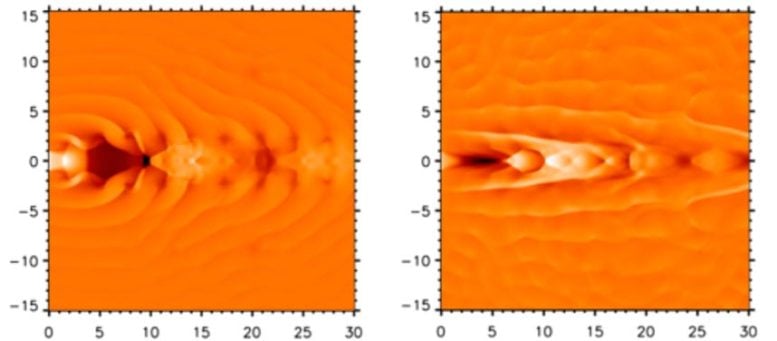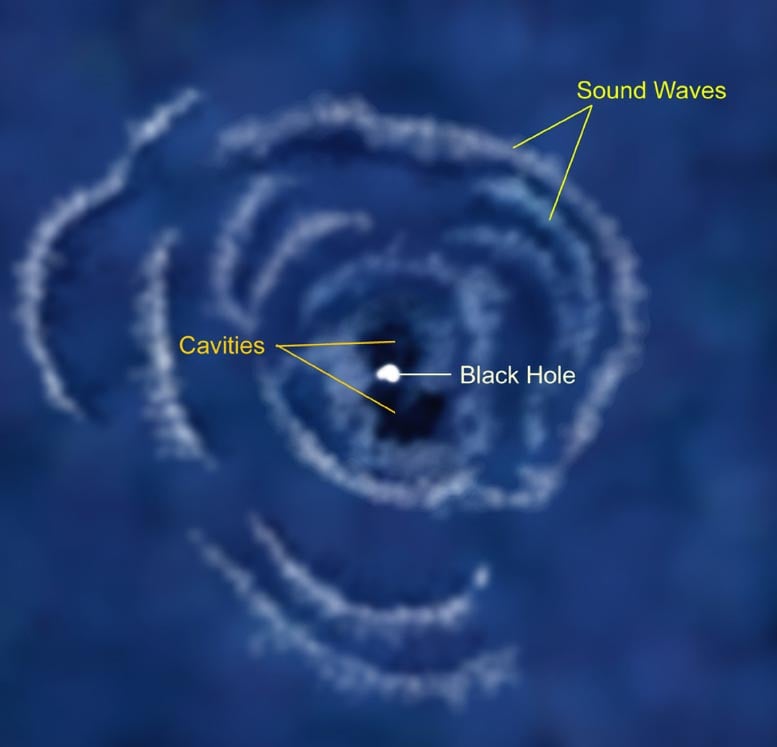
Artist’s impression showing bipolar gas jets from a supermassive black hole at the centre of a galaxy. Credit: ESA/Hubble, L. Calçada (ESO)
A study has revealed that galaxies have a regulatory mechanism similar to a heart and lungs, which controls their growth by limiting the absorption of gas.
This mechanism, involving a supermassive
” data-gt-translate-attributes=”({“attribute”:”data-cmtooltip”, “format”:”html”})” tabindex=”0″ role=”link”>black hole and its jet emissions prevent galaxies from expanding too quickly, thus ensuring their longevity and preventing premature aging into “zombie” galaxies.
Galaxies avoid premature death because they have a “heart and lungs” that efficiently regulate their “breathing” and prevent them from growing out of control, a new study suggests.
If this were not the case, the Universe would have aged much faster and all we would see today are huge “zombie” galaxies teeming with dead or dying stars.
This is what a new study published in the Monthly Notices of the Royal Astronomical Society, which investigates one of the great mysteries of the Universe: why galaxies are not as big as astronomers think.
Something seems to be stifling their enormous potential by limiting the amount of gas they absorb to become stars, meaning that instead of growing endlessly, something inside is resisting what was thought to be the inevitable pull of gravity.
This clip shows a supersonic jet generating a ‘bellows action’, receiving impulses from its black hole ‘core’, causing it to expand and contract ‘like a lung filled with air’, ‘exhaling hot air’ (pressure ripples) into its surroundings. The axes of the graph are dimensionless distance scales. Credit: C Richards/MD Smith/University of Kent
Analogy of heart and lungs in galaxies
Now, astrophysicists at the University of Kent think they have discovered the secret. They suggest that galaxies may actually be controlling the rate at which they grow through their ‘breathing’.
In their analogy, the researchers compared the supermassive black hole at the center of a galaxy to its core, and the two bipolar supersonic jets of gas and radiation they emit to the airways feeding a pair of lungs.
Pulses from the black hole — or “core” — can cause shock fronts to oscillate back and forth along the jet’s two axes, much like the human body’s thoracic diaphragm moves up and down inside a chest cavity to inflate and deflate the two lungs.
This can cause a massive transmission of the jet’s energy into the surrounding medium, much like we exhale hot air, slowing the accretion and growth of the galaxy’s gas.

Two different examples of simulating one side of symmetric bipolar jets, where pressure ripples propagate through the extragalactic medium. Pressure variations are shown here using a red-temperature colour scale (dark = low pressure, light = high pressure). Each jet enters from the left with pressure dropping rapidly as it pushes against the surrounding medium. Axes are dimensionless distance scales. Credit: C Richards/MD Smith/University of Kent
Simulation perspectives and galactic dynamics
PhD student Carl Richards came up with the theory after creating new, never-before-tested simulations to study the role supersonic jets might play in inhibiting galaxy growth.
This was to allow the “core” of the black hole to pulsate and the jets to be at high pressure – a bit like a form of hypertension, if we extend the comparison to the human body.
This caused the jets to “act like bellows,” he explained, sending sound waves “like ripples across the surface of a pond.”
These phenomena are similar to the terrestrial equivalent of the sound and shock waves produced when a bottle of champagne is opened, a car screeches, a rocket exhaust pipe or pressurized vessels are punctured.

Sound waves (ripples) in the hot gas filling the Perseus cluster are shown in this artist’s impression. They are thought to be generated by cavities blown out by jets from a supermassive black hole (bright white spot) at the center of the galaxy. Credit: NASA/NASA/CXC/M.Weiss
“We realized that there would have to be a way for the jets to support the body – the ambient gas surrounding the galaxy – and that’s what we found in our computer simulations,” Richards said.
“The unexpected behavior was revealed when we analyzed computer simulations of high pressure and let the heart pulse.
“This sent a stream of pulses into the high-pressure jets, causing them to change shape under the bellows action of the jets’ oscillating shock fronts.”
These supercharged jets actually expanded “like lungs filled with air,” the researchers said.
In doing so, they transmitted sound waves into the surrounding galaxy as a series of pressure ripples, which were later found to slow the galaxy’s growth.
Conclusion and future prospects
There is evidence for ripples in extragalactic media, such as those seen in the nearby Perseus galaxy cluster, associated with huge bubbles of hot gas, which are considered examples of sound waves.
These ripples were already thought to be responsible for maintaining the ambient environment of a galaxy, although a mechanism to generate them was lacking.
Conventional cosmological simulations are therefore unable to account for the gas flows in galaxies, leading to one of the great mysteries of the Universe. It therefore relies on the highly active black hole at the heart of a galaxy to provide some resistance.
“It’s not easy, though, and we have constraints on the type of pulsation, the size of the black hole and the quality of the lungs,” said co-author Professor Michael Smith.
“Breathing too fast or too slow will not provide the vital tremors needed to maintain the galactic environment and, at the same time, to supply fuel to the heart.”
The researchers concluded that a galaxy’s lifespan can be extended by using its “heart and lungs,” where the supermassive black hole engine at its core helps inhibit growth by limiting the amount of gas collapsing into stars at an early stage.
This, they say, is what helped create the galaxies we see today.
Without such a mechanism, galaxies would have already exhausted their fuel and died out, as some of them do in the form of “red and dead” or “zombie” galaxies.
Reference: “Simulations of pulsed overpressure jets: formation of bellows and ripples in galactic environments” by Carl Richards and Michael D Smith, July 12, 2024, Monthly Notices of the Royal Astronomical Society.
DOI: 10.1093/mnras/stae1498